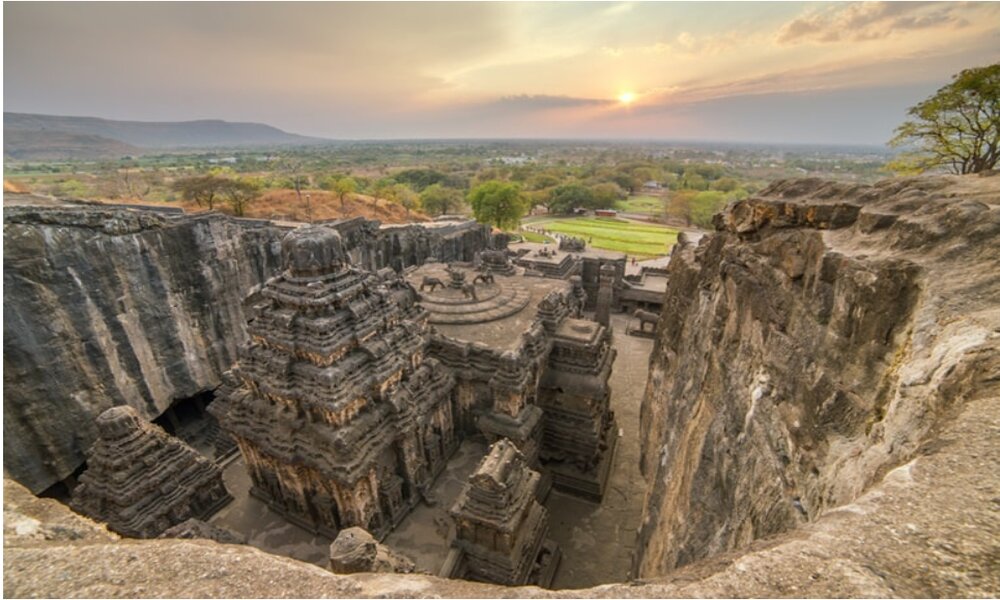The Ellora Caves, located in the Aurangabad district of Maharashtra, India, is a magnificent masterpiece of ancient Indian rock-cut architecture. It is a UNESCO World Heritage Site that attracts thousands of visitors every year from all over the world.
The Ellora Caves are a unique combination of art, culture, and religion, featuring some of the most beautiful and intricately carved rock-cut temples, monasteries, and shrines. This article will provide a comprehensive guide to the Ellora Caves, including their history, architecture, significance, and tourist information.
History of Ellora Caves
The Ellora Caves were built during the period between the 6th and 10th centuries AD. The construction of these caves began during the reign of the Rashtrakuta dynasty, who ruled the Deccan region of India from the 6th to the 10th centuries AD.
The Rashtrakutas were great patrons of art and architecture, and they encouraged the development of rock-cut architecture in the region. The Ellora Caves were built by skilled craftsmen and artisans who carved out the rock with chisels and hammers.
The construction of these caves took several centuries, and it involved the contribution of various dynasties, including the Chalukyas, the Rashtrakutas, and the Yadavas.
Architecture of Ellora Caves
The Ellora Caves are a magnificent example of ancient Indian rock-cut architecture. The caves are carved out of solid basalt rock, and they feature some of the most intricate and exquisite carvings and sculptures. There are a total of 34 caves at Ellora, out of which 12 are Buddhist, 17 are Hindu, and 5 are Jain. Each of these caves represents a unique blend of art, culture, and religion.
Buddhist Caves
The Buddhist caves at Ellora are located at the southern end of the complex. These caves were built between the 6th and 8th centuries AD and they feature some of the finest examples of Buddhist art and architecture.
The most significant Buddhist cave at Ellora is Cave 10, also known as the Vishvakarma Cave. This cave features a magnificent statue of Buddha seated on a lotus throne, flanked by Bodhisattvas and attendants. The walls of the cave are adorned with exquisite carvings depicting scenes from the life of Buddha.
Hindu Caves
The Hindu caves at Ellora are located in the middle of the complex. These caves were built between the 7th and 10th centuries AD and they feature some of the most beautiful and intricate carvings and sculptures of Hindu deities.
The most significant Hindu cave at Ellora is Cave 16, also known as the Kailasa Temple. This cave is dedicated to Lord Shiva and it is considered to be one of the most remarkable examples of rock-cut architecture in the world.
The Kailasa Temple features a towering gateway, a huge courtyard, and a grand hall with exquisite carvings depicting scenes from Hindu mythology.
Jain Caves
The Jain caves at Ellora are located at the northern end of the complex. These caves were built between the 9th and 10th centuries AD and they feature some of the most impressive and intricate carvings and sculptures of Jain deities.
The most significant Jain cave at Ellora is Cave 32, also known as the Indra Sabha. This cave features a magnificent statue of the Tirthankara, Rishabhanatha, seated on a lotus throne, flanked by Yakshas and Yakshinis. The walls of the cave are adorned with beautiful carvings depicting scenes from Jain mythology.
Significance of Ellora Caves
The Ellora Caves are of great significance to Indian history and culture. They represent the cultural, artistic, and religious heritage of India, and they showcase the ancient Indian craftsmanship and engineering skills.
The Ellora Caves also reflect the spirit of religious tolerance and harmony that prevailed in ancient India, where people of different faiths lived and worshiped together. The Ellora Caves are a testament to the rich and diverse cultural heritage of India and they are an inspiration for people around the world to appreciate and celebrate cultural diversity.
Tourist Information
The Ellora Caves are open to visitors all year round, and they are a popular tourist destination in India. The best time to visit the caves is between October and March when the weather is pleasant and mild.
The caves are open from sunrise to sunset, and visitors are advised to wear comfortable clothing and footwear. It is also recommended to carry water and sunscreen as the caves can be quite hot during the daytime. Visitors are not allowed to bring food, drinks, or pets inside the caves.
There are several ways to reach the Ellora Caves. The nearest airport is Aurangabad Airport, which is about 30 km away from the caves. Aurangabad is also well connected by road and rail, and there are regular bus and train services from major cities in India.
There are several accommodation options available near the Ellora Caves, including budget hotels, guesthouses, and luxury resorts.
Conclusion
The Ellora Caves are a marvel of ancient Indian rock-cut architecture that showcases the cultural, artistic, and religious heritage of India. They are a must-visit destination for anyone interested in history, art, and culture.
The caves are a living testament to the ancient Indian craftsmanship and engineering skills, and they inspire people around the world to appreciate and celebrate cultural diversity. The Ellora Caves are truly a wonder of the world, and they continue to captivate and enchant visitors with their beauty and splendor.
READ MORE
- Exploring the Intricate Carvings of the Sun Temple
- Nalanda University: The Ancient Seat of Learning that Continues to Inspire
- Unakoti: A Magnificent Archeological Wonder
- Rani Ki Vav: A Magnificent Stepwell of India
- Sarojini Naidu: The Nightingale of India
- The Hidden Dangers of Tapeworm Infection
- Mata Vaishno Devi: A Holy Pilgrimage Destination in India
- Celebrating Meme Creators Day:
- पत्रकारिता जगत में संपादन के siddhant की जरूरत
- Radio का इतिहास और विकास यात्रा
- संपादन का अर्थ, उद्देश्य, महत्व और संपादन में पुनर्लेखन

